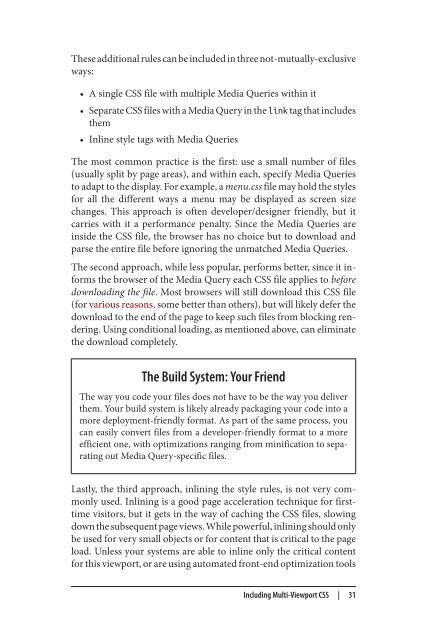responsive-and-fast-implementing-high-performance-responsive-design
responsive-and-fast-implementing-high-performance-responsive-design
responsive-and-fast-implementing-high-performance-responsive-design
You also want an ePaper? Increase the reach of your titles
YUMPU automatically turns print PDFs into web optimized ePapers that Google loves.
These additional rules can be included in three not-mutually-exclusive<br />
ways:<br />
• A single CSS file with multiple Media Queries within it<br />
• Separate CSS files with a Media Query in the link tag that includes<br />
them<br />
• Inline style tags with Media Queries<br />
The most common practice is the first: use a small number of files<br />
(usually split by page areas), <strong>and</strong> within each, specify Media Queries<br />
to adapt to the display. For example, a menu.css file may hold the styles<br />
for all the different ways a menu may be displayed as screen size<br />
changes. This approach is often developer/<strong>design</strong>er friendly, but it<br />
carries with it a <strong>performance</strong> penalty. Since the Media Queries are<br />
inside the CSS file, the browser has no choice but to download <strong>and</strong><br />
parse the entire file before ignoring the unmatched Media Queries.<br />
The second approach, while less popular, performs better, since it informs<br />
the browser of the Media Query each CSS file applies to before<br />
downloading the file. Most browsers will still download this CSS file<br />
(for various reasons, some better than others), but will likely defer the<br />
download to the end of the page to keep such files from blocking rendering.<br />
Using conditional loading, as mentioned above, can eliminate<br />
the download completely.<br />
The Build System: Your Friend<br />
The way you code your files does not have to be the way you deliver<br />
them. Your build system is likely already packaging your code into a<br />
more deployment-friendly format. As part of the same process, you<br />
can easily convert files from a developer-friendly format to a more<br />
efficient one, with optimizations ranging from minification to separating<br />
out Media Query-specific files.<br />
Lastly, the third approach, inlining the style rules, is not very commonly<br />
used. Inlining is a good page acceleration technique for firsttime<br />
visitors, but it gets in the way of caching the CSS files, slowing<br />
down the subsequent page views. While powerful, inlining should only<br />
be used for very small objects or for content that is critical to the page<br />
load. Unless your systems are able to inline only the critical content<br />
for this viewport, or are using automated front-end optimization tools<br />
Including Multi-Viewport CSS | 31


